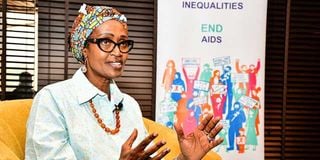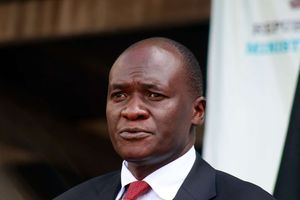Aids killed one person per minute last year: UN report

UNAids Executive Director Winnie Byanyima during a past interview in Nairobi.
What you need to know:
- Globally, in 2022, approximately 210,000 adolescent girls and young women (aged 15–24 years) acquired HIV, half as many as in 2010.
- In the same year, 140 000 adolescent boys and young men (aged 15–24 years) acquired HIV, a 44 per cent reduction since 2010,” the report highlights.
A new report released by UNAIDS shows that last year, Aids killed one person per minute in sub-Saharan Africa. Women and girls in the region remained the most vulnerable.
Speaking at the launch of the 2023 UNAIDS global Aids Update in Geneva, Switzerland, Winnie Byanyima, the executive-director of UNAIDS (United Nations Programme on HIV/AIDS), said despite the giant strides the world has made in combating the HIV epidemic, the high rate of infections among women and girls in sub-Saharan Africa as well as childhood HIV infections continue to hamper progress.
“Four thousand adolescent girls and young women acquired HIV every single week, that’s a crisis. Three thousand and one hundred of those are from Sub-Saharan Africa and so it’s a sub-Saharan crisis.”
She, however, pointed out that the data and evidence in the report shows there is a path to end Aids by 2030.
“The path that ends Aids is the same path that will help societies to be prepared for future pandemics and that will also help countries to achieve the sustainable development goals.”
“In 2022, in sub-Saharan Africa, women and girls (of all ages) accounted for 63 per cent of all new HIV infections and only about 42 per cent of districts with very high HIV incidence in sub-Saharan Africa are currently covered with dedicated prevention programmes for adolescent girls and young women.
“Closing these gaps and making it easier for sexually active girls and women to access female-friendly biomedical prevention tools such as oral PrEP and the dapivirine vaginal ring, would greatly reduce their risks of acquiring HIV,” UNAIDS said.
As per the latest data, globally, almost three-quarters (71 per cent) of people living with HIV in 2022 (76 per cent of women and 67 per cent of men living with HIV) had suppressed viral loads.
Viral suppression enables people living with HIV to live long, healthy lives and to have zero risk of transmitting HIV sexually. However, in children, it was only 46 per cent.
The estimated 1.3 million (1.0 million–1.7 million) new HIV infections in 2022 were the fewest in decades, with the declines especially strong in regions with the highest HIV burdens.
UN experts also observed that the steepest drops in numbers of new infections have been among children (aged 0–14 years) and young people (aged 15–24 years) who in recent years have been targeted with effective interventions.
“Globally, in 2022, approximately 210,000 adolescent girls and young women (aged 15–24 years) acquired HIV, half as many as in 2010. In the same year, 140 000 adolescent boys and young men (aged 15–24 years) acquired HIV, a 44 per cent reduction since 2010,” the report highlights.
According to the 2023 UNAIDS report, Botswana, Eswatini, Rwanda, Tanzania and Zimbabwe have already achieved the 95-95-95 targets. That means 95 per cent of the people who are living with HIV knowing their HIV status, 95 per cent of the people who know that they are living with HIV being on lifesaving antiretroviral treatment, and 95 per cent of people who are on treatment being virally suppressed. At least 16 other countries including eight in sub-Saharan Africa like Kenya and Thailand are close to achieving their targets.
Ms Byanyima said the report also noted that the biggest breakthroughs are occurring in countries that have forged and maintained strong political commitment to put people first and invest sufficiently in proven strategies. “They have prioritised inclusive approaches that respect people’s human rights, and they have engaged affected communities across the HIV response.
“They have acted to remove or defuse the societal and structural factors that put people in harm’s way and prevent them from protecting their health and well-being—including criminalising laws and policies, gender and other inequalities, stigma and discrimination, and human rights violations,” the report said.
UNAIDS pointed out that HIV programmes succeed when public health priorities prevail, as experiences in multiple countries attest.
“In Botswana and Cambodia, evidence-based polices and scaled up responses have paid off in reducing new HIV infections and Aids-related deaths. Cameroon, Nepal and Zimbabwe have achieved major reductions in new HIV infections due to focused prevention programmes,” the findings observed while further disclosing that the number of people on pre-exposure prophylaxis (PrEP) in Latin America has increased by over 55 per cent since 2021, with 10 countries providing PrEP to people from key populations in 2022.
The UN lauded Thailand, which it said is well on its way to achieving the 95– 95–95 targets and has successfully integrated a response to addressing stigma and discrimination into its national HIV response.
“UNAIDS data show that today, 29.8 million of the 39 million people living with HIV globally are receiving life-saving treatment.An additional 1.6 million people received HIV treatment in each of 2020, 2021 and 2022,” the findings show.
“If this annual increase can be maintained, the global target of 35 million people on HIV treatment by 2025 will be within reach.”
Access to antiretroviral therapy has expanded massively in sub-Saharan Africa and Asia and the Pacific, which together are home to about 82 per cent of all people living with HIV,” the report says while observing that the path to ending AIDS is clear.
“We have a solution if we follow the leadership of countries that have forged strong political commitment to put people first and invest in evidence-based HIV prevention and treatment programmes.
The building blocks of a successful AIDS response come together through partnerships between countries, communities, donors including the United States President’s Emergency Plan for AIDS Relief , the Global Fund to Fight, AIDS, Tuberculosis and Malaria (the Global Fund) and the private sector.”





